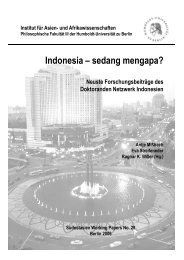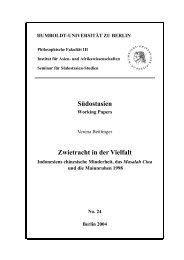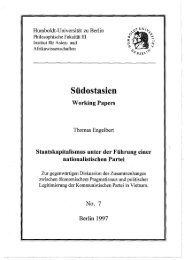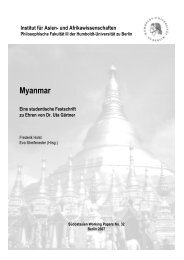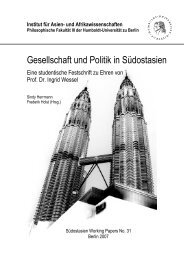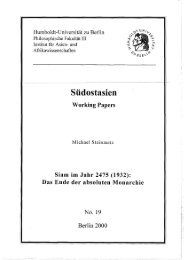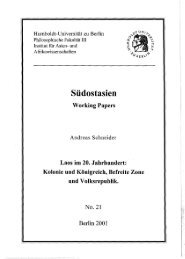On Centrism and Dualism - Humboldt-Universität zu Berlin
On Centrism and Dualism - Humboldt-Universität zu Berlin
On Centrism and Dualism - Humboldt-Universität zu Berlin
Create successful ePaper yourself
Turn your PDF publications into a flip-book with our unique Google optimized e-Paper software.
CENTRISM AND DUALISM<br />
LÉVI-STRAUSS, still unsatisfied with these attempts at underst<strong>and</strong>ing social organization in<br />
cognatic societies, proposed that his characterization of the house should be applied to all<br />
those societies where anthropologists, following the premises of descent theory, encountered<br />
analytical problems. LÉVI-STRAUSS saw these problems resulting not only from an incomplete<br />
set of structural types but, more fundamentally, from a non-workable substantivist or<br />
essentialist orientation to social organization (GILLESPIE 2000b: 28-29).<br />
Part of this orientation was the concept of corporate group that was defined according to<br />
principles such as descent or residence. LÉVI-STRAUSS indicates that this concept derives from<br />
an English jural unit <strong>and</strong> its juridical application would not match the French equivalent<br />
‘personne moral’. Because of the Anglo-American anthropologists’ tendency to assign people<br />
to specific corporate groups, it had become axiomatic to ‘cut up social reality’ into groups<br />
with bounded <strong>and</strong> mutually exclusive membership <strong>and</strong> to classify various kinship practices<br />
into ‘types’ based on the specific principles followed in any single society to delimit such a<br />
group (ibid.: 29).<br />
These fundamental assumptions become an analytical problem in societies which trace their<br />
kinship relations ‘cognatically’ or ‘bilaterally’, as is the case in large parts of Southeast Asia.<br />
Here the people appeared to organize themselves into corporate groups despite the absence of<br />
consistently applied rules. Groupings often have vague or permeable boundaries <strong>and</strong><br />
recruitment to them often does not strictly follow genealogical or descent lines. Even<br />
‘kinship’ (in the sense of a belief in shared body substance) sometimes does not feature in<br />
either the formation of groups or the reference of what we call ‘kinship’ terminology (cf.<br />
ERRINGTON 1989: 235). The indefiniteness <strong>and</strong> porousness of the group boundaries<br />
questioned the groups’ function as jural entities as well as the presumed fixity of kin-based<br />
social identity (GILLESPIE 2000b: 29).<br />
Staying true to the premises of his structuralism, LÉVI-STRAUSS criticizes the overemphasis of<br />
principles used to delimit group membership <strong>and</strong> express group boundaries. This would<br />
undervalue the relationships established <strong>and</strong> maintained between groups. To him the houses<br />
of what he considers to be house societies become most visible in their interaction with one<br />
another (ibid.)<br />
It is thus a dynamic formation that cannot be defined in itself, but only in relation to others of the<br />
same kind, situated in their historical context (LÉVI-STRAUSS 1987: 178).<br />
38



